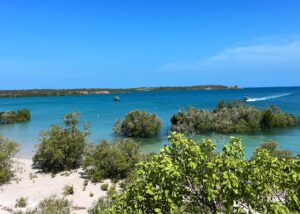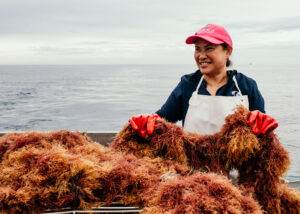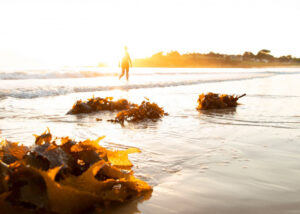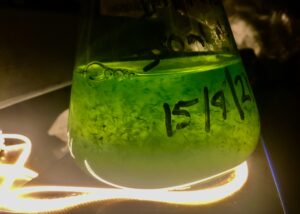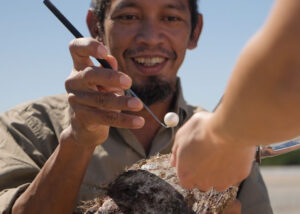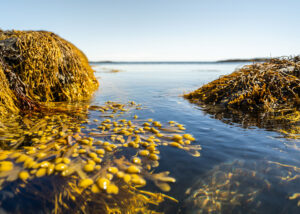Lukina Lukin has already gone where few would fear to tread – taking on her late husband’s tuna farm on the wild shores of Port Lincoln. Now she’s pushing at new boundaries, trialling a seaweed fertiliser project that could reinvent finfish farming for the better.
By any measure, Lukina Lukin has had a remarkable life. In 1995, aged 29, she was on an exchange programme from Thailand, teaching in Port Lincoln. The outpost on the wild coastline of South Australia’s Eyre Peninsula was a long way from her home province of Chachoengsao near Bangkok where her family farmed rice – yet it was here she met and fell in love with a tough Croatian migrant called Dinko Lukin.
Dinko was one of Lincoln’s famed ‘tuna barons’. It was Lukin who, in the 1980s, innovated a revolutionary system of farming valuable southern bluefin tuna. Wild fish were caught in the formidable Southern Ocean and towed slowly back to Port Lincoln in nets. Here they were transferred to huge circular ‘tuna cages’, fed sardines and fattened for export. It was never an industry for the faint-hearted.
“The first time Dinko took me out on a tuna boat, I was seasick!” recalls Lukina. Not that this stopped the pair from marrying and Lukina becoming a part of the operation. “I was always learning from him. He taught me everything – how to change an oil filter, how to repair a tuna net, how to drive a forklift…”
In 2011, Dinko passed away and left his business to Lukina, along with his allocation of southern bluefin tuna and a $32-million-dollar debt. Against the odds, indeed against most of the expectations of the $150m dollar SBT industry, she turned the company around. Today, Dinko Seafoods and Dinko Tuna Farmers turn over some $8m a year.
Lukina calls herself a ‘slow learner’ but she’s proved to be as innovative as her late husband. She says if she has a question in her head, she can’t let it go until it’s resolved.
In 2021, one of those questions was ‘how can I improve water flow through my tuna cages?’
Lukina’s lease off Lincoln’s shores hosts six cages, each holding up to 50 tonnes of the fast-swimming fish. The fish create nutrient waste including nitrogen, phosphorous and carbon. This causes seaweed to flourish on the nets, restricting waterflow and diminishing oxygen levels which affects the growth of the tuna.

Tuna cage; credit SARDI
“We have to clean the seaweed off our nets every year. It takes, like, weeks – divers use a high-pressure hose and wash it away before we bring the net in for repair. So I started to think – how can we keep the nets open and the water flowing?”
Around this time, Lukina had been consulting with the South Australian Research and Development Institute (SARDI). She was looking to start new commercial projects and in 2019, had trialled growing the native red seaweed Asparagopsis for the stock feed industry. The crop, however, didn’t perform well in the trials.
Meanwhile Dr Sasi Nayar, Aquaculture Programme Leader with SARDI had become interested in the sheer variety of seaweed species that flourished on the netting of Lukina’s tuna cages.
“Each cage has eight mooring lines anchoring it to the seabed at about 24 metres,” says Sasi. “So we looked at various sections of these lines to see what things grew and by how much. We found that there were nearly 100-odd species that were settling. And that gave us a lot of ideas…”
Those ideas led to a multi-faceted project which won kickstarter funding from MBCRC in 2022.
Sasi and Lukina wanted to explore the potential of harvesting biofouling seaweed to create a seaweed-based fertiliser that was 100 per cent Australian made. The commercial outcome would not only dovetail perfectly with the tuna farm (which only operates for six months in winter) it would also provide a critical environmental outcome.
“We wanted to see if we could extract out the nutrients created by finfish farming in the coastal waters off Port Lincoln,” says Sasi.
Key to the pilot project was a settlement line not dissimilar to those used by mussel farmers. The line comprises a 160-metre long surface rope with a series of looped lines hanging off it, reaching some 15 metres down. The line amounts to 6.7 kilometres of rope on which to grow ‘highly opportunistic’ seaweed.
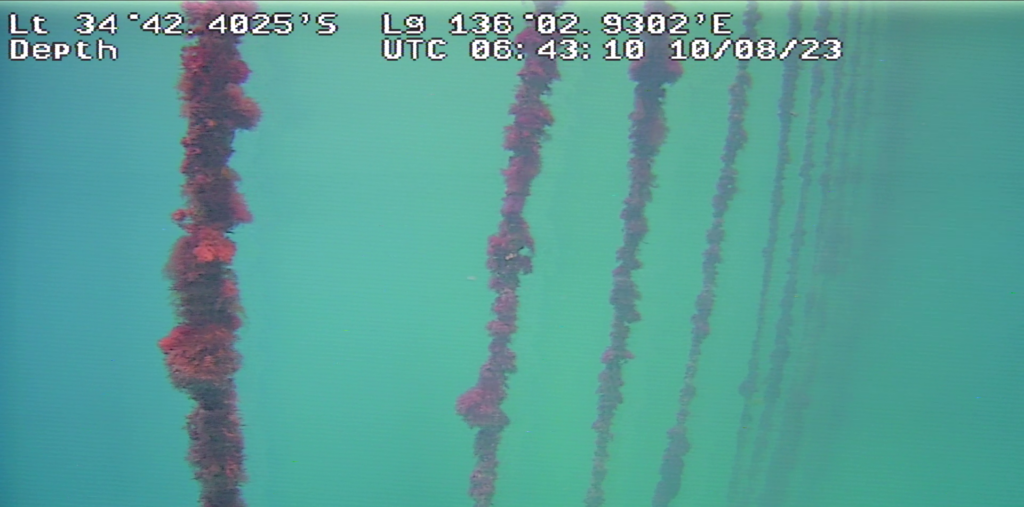
Settlement lines underwater; credit SARDI
By encouraging species to populate the line, the team are effectively creating a curtain of seaweed which in turn absorbs the fish farm’s nutrients. “We’re trying to encourage biofouling of the line to rapidly assimilate bioavailable nutrients. The key is to frequently harvest the seaweed: the moment you harvest them, they go back into early growth and they assimilate a lot more nutrients.”
Sasi envisages a time when hundreds of settlement lines could be arranged around Eyre Peninsula’s fish farms, absorbing nutrients left by populations of farmed tuna and kingfish.
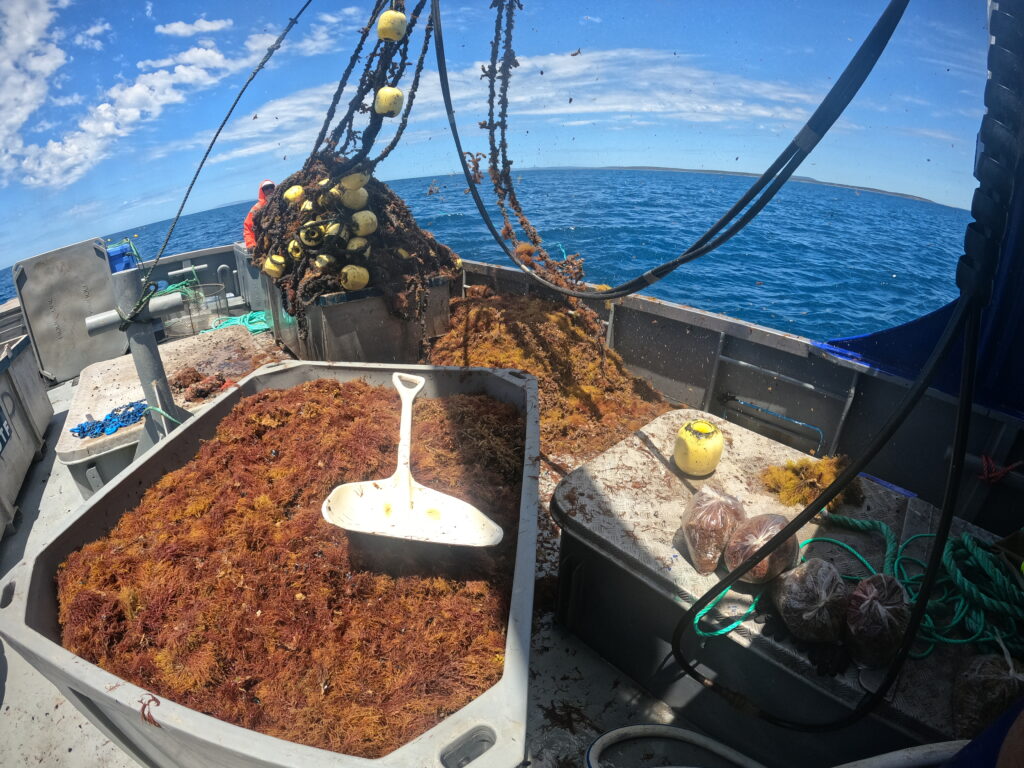
Harvesting from the settlement lines; credit SARDI
The line at Lukina’s farm was positioned some 200 metres to one side of the tuna cages and aligned with the tides to optimise assimilation. Lukina believes the line had a positive impact on her cages because biofouling was reduced – possibly because the line presented a better opportunity for the species to colonise, and possibly because the hungry ‘curtain’ was taking the lion’s share of the nutrients. “There was less growth on the nets,” she says. “The mesh stayed open and the waterflow was very good. The fish were healthy.”
Dinko Tuna Farmers’ first seaweed harvest was done in December 2022, when the single line realised 2.5 tonnes of seaweed.
Samples of the seaweed were sent to SARDI’s West Beach laboratories for mincing and digesting with enzymes. The researchers, however, were looking for more than a simple seaweed-based formula.

Small batch; credit SARDI
“We wanted to refine the product to get a better quality fertiliser for fruit trees and for wineries,” says Lukina. “We’re particularly interested in vineyards. We want to increase the yield of grapes but also improve the soil quality. Rock phosphate-based fertilisers can cause moisture problems in soils, whereas seaweed fertiliser can [overcome] that.”
According to Sasi, the seaweed-based fertiliser is a biostimulant high in vitamins, trace elements and growth promoters. “According to research, when you spray seaweed biostimulants on vineyards, it not only increases yield, it also increases disease resistance, pest resistance and makes the plant more heat tolerant. For the viticulture industry, it’s a very big thing.” Sasi says wine growers in Port Lincoln and Clare Valley have tentatively agreed to trial the product in 2024. “It will be 100 per cent Australian made and certified organic – which are also key for retailers.”
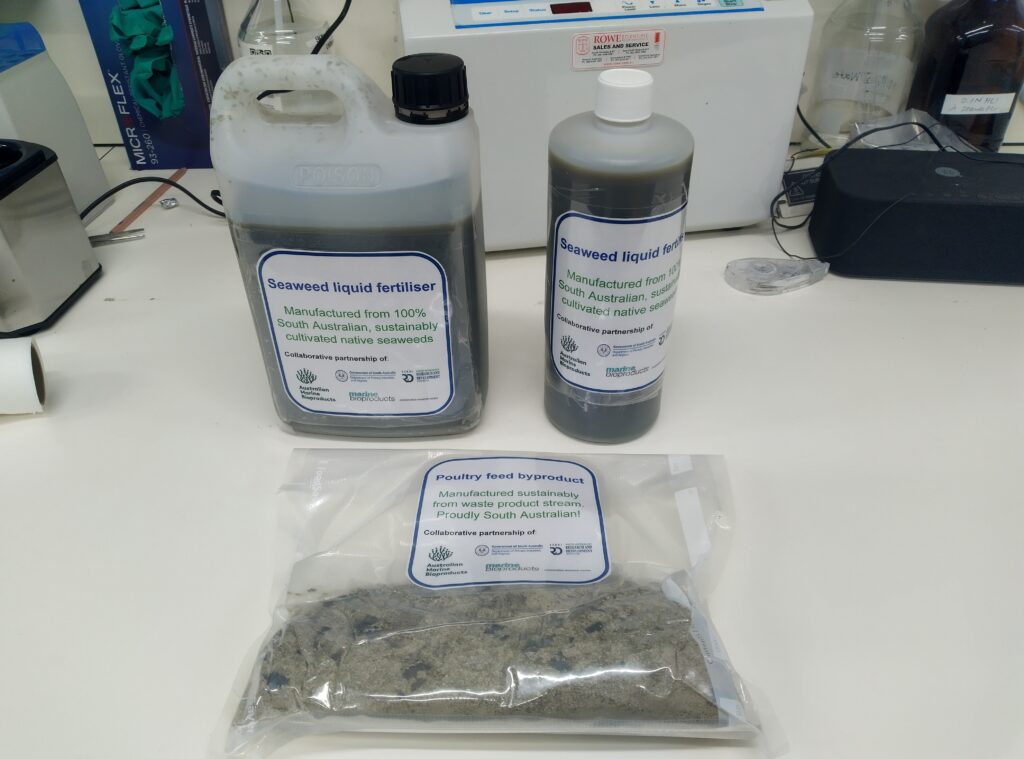
Seaweed liquid fertiliser and poultry feed; credit SARDI
The team have created a second fertiliser product using different waste products from Dinko Seafoods. “We’re aiming to make the operation zero waste,” says Sasi, “so we’re also targeting the tuna offal [processing waste] and broken sardines [from the tuna feed], which currently goes to landfill.” This fish-based fertiliser is high in macro-nutrients like phosphorous and nitrogen. Sasi says a third fertiliser product is in their sights – a powerful blend of this with the seaweed biostimulant.
The waters off Eyre Peninsula are some of the most species-rich waters in the world when it comes to seaweed. Lukina says it’s ‘pot luck’ as to what grows on her line, which is now back out in the water for its second season. But with an estimated 1,500 species in the Southern Ocean, she might well be fishing for entirely new revenue streams.
“Right now, the easiest way for us to deal with the harvest is to turn everything into fertiliser,” she says. “But once we get a bit of success, we can look at each seaweed species and decide what can be good for use in food, in pharmaceuticals and cosmetics.”
Dinko Tuna Farms and SARDI have already been looking at the pigment phycoerythrin, a valuable commodity realised from a native red seaweed species currently being cultivated at West Beach. The all-natural purified pigment commands up to $US250,000 per kilo in overseas markets.
“There’s a lot of colour used in cosmetics like eyeshadow and lipsticks,” says Lukina. “But this is not chemical colour, it’s organic colour. If we can extract these seaweed species from the line and grow them separately, there will be better value.”
For Lukina, her seaweed projects are promising to be a win-win-win. She’s reducing waste and biofouling, cleaning up the oceans and creating a revenue stream as well as out-of-season employment. But it’s not just about her company’s fortunes – she’s aiming to realise benefits for the wider region and for the aquaculture industry as a whole. “Cleaning up the ocean, reducing waste and improving the soils,” she says. “That can only be a good thing, right?”
Her late husband Dinko Lukin is remembered as one of the pioneers of the tuna industry. Lukina Lukin could well be creating a similar legacy.
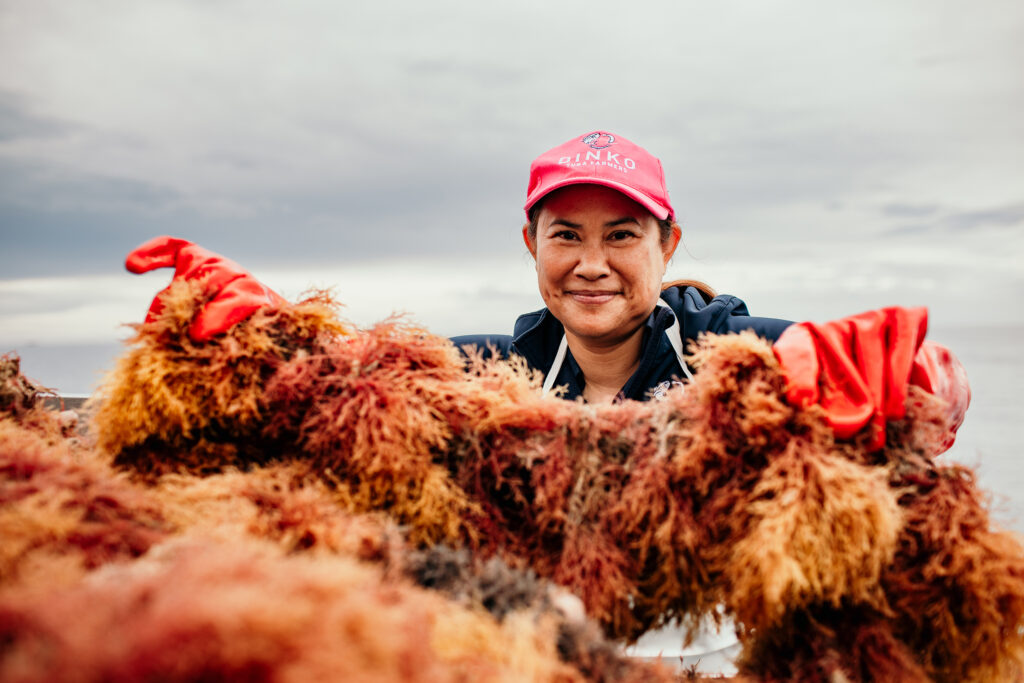
Lukina Lukin; credit Dinko Tuna



